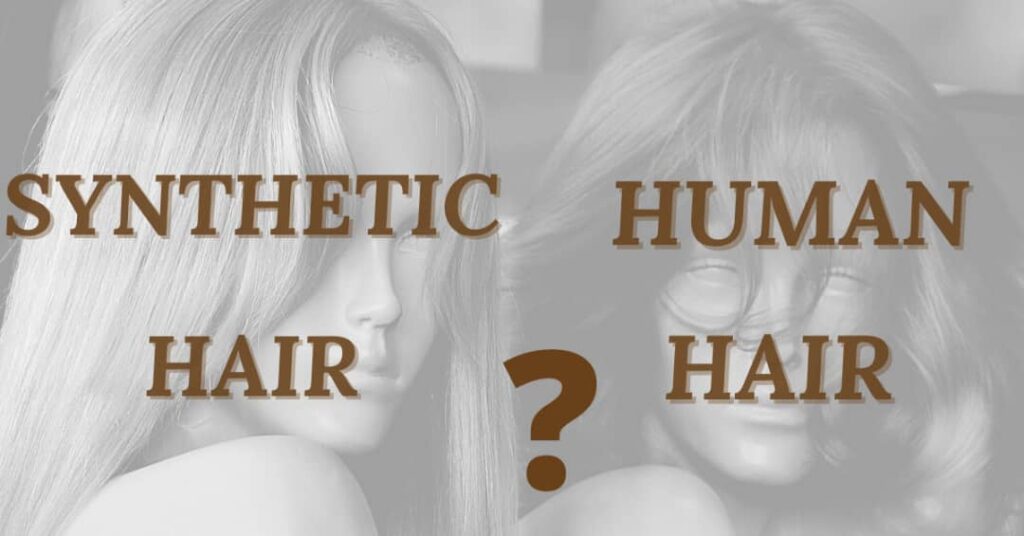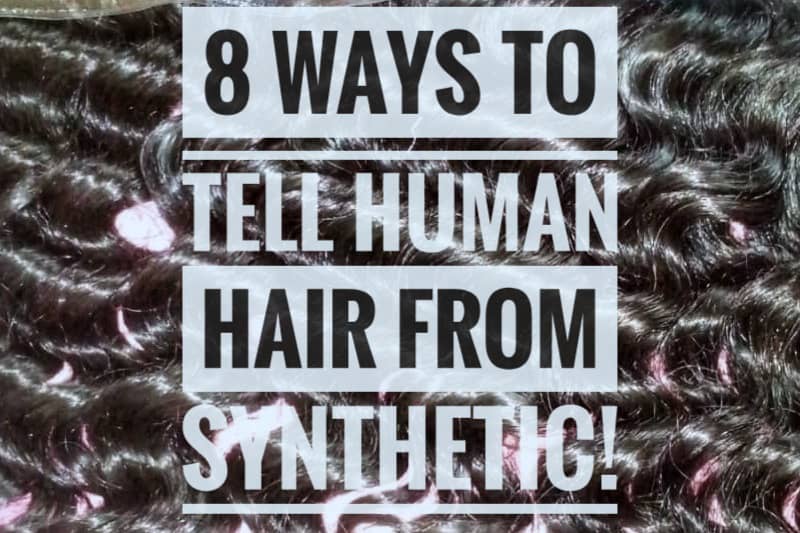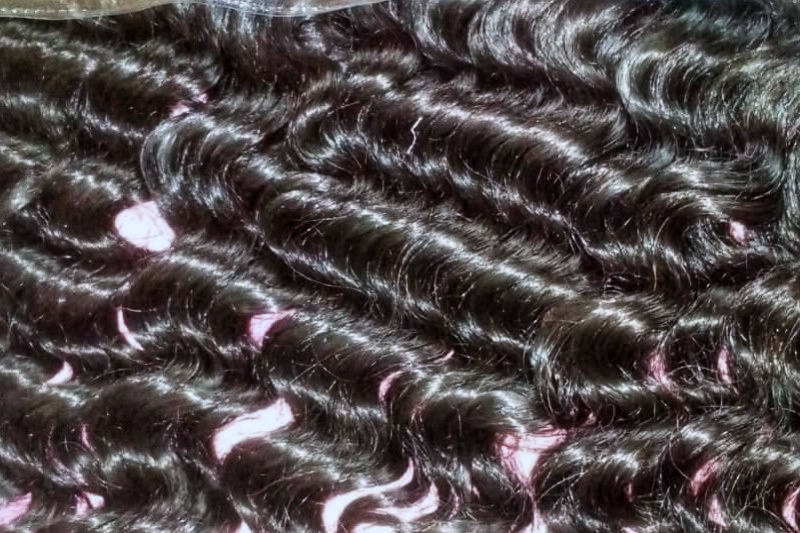Buying human hair weaves should be an investment, a guarantee that you have something to count on to look good for months or even years.
However, it breaks the heart when you spend a lot on ‘human hair’ only to find out that you’ve gotten plain synthetic hair mainly because you do not know how to tell human hair from synthetic hair.
And all too often, we hear news of people falling victim – buying ‘human hair’ only to find it looking like a sponge in a few weeks.
While such news, tweets, or videos may sometimes come off as funny or exciting, we can only imagine how depressing it must be for the victims. In this post, you’ll learn how to tell human hair from synthetic hair effectively, so you never fall victim to buying fake hair – again, if you’ve been a victim once.
A key to telling the difference is knowing precisely what human hair is and what synthetic hair is. So let’s kick off with that!

What is Human Hair?
As the name implies, human hair is made from natural hair sourced from China, Asia, and Europe. This type of hair has not been mixed with artificial or any heat-resistant fiber. They can be classified into Remy hair, Virgin hair, and Non-Remy hair.
Knowing these types will reduce your chances of buying fake hair and help you be more specific when deciding what kind of hair to purchase.
1. Virgin Hair
Virgin hair is the term used to refer to 100% real human hair. This type of human hair has not been given any processing, neither chemical processing nor heat processing.
It comes straight from hair donors with natural, healthy, and usually long hair; hence, no need for further processing. Once gotten, the hair is picked to form thick, long ponytails.
As you can expect from something as real as that, virgin hair is usually costly. But it also lasts for very long so you can say the price is worth it.
2. Remy Hair
Remy hair is also gotten from hair donors but undergoes a bit of processing. It is usually from a combination of hair donors and not a single one.
Like shingles on a roof, Remy’s hair has its root and tips arranged in one direction. Hence it doesn’t get tangled easily. While it is less expensive than virgin hair, it is more costly than the non-Remy hair type.
Note that the majority of human hair we see around is the Remy hair type. Remy hair can be straightened, flat ironed, or even dyed. But, of course, it is also of high quality and can last for a long time.
3. Non-Remy Hair
Unlike Remy’s hair, non-Remy hair does not have its roots and tips aligned in one direction. It is usually gotten from average suppliers, and its method of processing makes it prone to tangles.
It goes through chemical processing but has excellent finishing that makes it look shiny and healthy. Hence, after a few washes, non-Remy hair tends to mat and tangle.
It lasts longer than synthetic hair but not as much as virgin or Remy human hair. Oh, by the way, the commonly called ‘human hair blend’ is a mix of non-Remy human hair.
What is Synthetic Hair?
Synthetic hair is made from artificial, synthetic fibers, specifically Acrylic, Polyester, Kanekalon, and Polyvinyl. These fibers are heated and made into single strands. These strands are then crafted into wefts, extensions, or hairpieces.
They are available in a variety of colors and sizes and are way less expensive than human hair. In most cases, they come pre-styled. Synthetic hair fibers are sometimes mixed with human hair to create a human hair blend.
Synthetic hair is categorized based on the fiber they are made from.
1. Kanekalon
This is the best grade of synthetic fibers. It might appear to be less shiny but feels more realistic when touched.
2. Other Synthetic Fibers
Acrylic, polyester, and polyvinyl fibers often look very shiny but feel less natural when touched. So you can generally tell how much quality synthetic hair has by checking how shiny it looks.
High-quality fibers such as Kanekalon look less shiny and somewhat dull. The more the shine, the less the quality.
Human Vs. Synthetic Hair
Human hair and synthetic hair have advantages and disadvantages peculiar to each hair type. For example, while synthetic hair is much more affordable and can resist bad weather, it does not last for very long, nor is it as versatile as human hair.
In this post, I compared human hair and synthetic hair, which can help you decide which is best for you. Here’s a summarized breakdown:
Advantages of Human Hair
- They look like natural hair
- They are comfortable to wear
- They can be used for very long
- They are easy to style and wear.
Advantages of Synthetic Hair
- They are less expensive
- They can resist bad weather
- They come in a variety of colors and sizes
Disadvantages of Human Hair
- They have a very high price
- They are easily affected by bad weather
Disadvantages of Synthetic Hair
- They do not last for very long
- They look and feel less natural
- They are less versatile
Human hair lasts for a very long time and is suitable for those who love to invest in hair that would last for years. Exactly why it would be unfortunate to end up with synthetic hair or even a human hair blend when the intention is to invest in human hair.
So now here’s the real deal, how do you tell human hair from synthetic?

How to Tell Human Hair from Synthetic Hair: 8 Tips
If you had to identify real money notes amid many fake notes, the best way to go about it would be to know the complete characteristics of a genuine note.
That way, when you come across a note without any of those characteristics, you know it’s fake. Similarly, the eight methods below are characteristics of human hair and what human hair would and would not do in different situations to tell human hair from synthetic successfully.
1. Water Test
Here’s one characteristic of human hair:
When water is applied, human hair maintains its lightweight and appears to curl, like real hair.
Synthetic hair, on the other hand, becomes heavier and stiff when wet. It also becomes prone to tangles. That explains why it is easier to dive into a swimming pool with human hair than synthetic hair.
So one way to tell human hair from synthetic? Wet it. If it maintains its weight and curls, you’ve got human hair right there.
Oh, don’t worry about it curling. You can quickly straighten it back using an appropriate hairstyling tool; flat iron. If it becomes heavier, however, and does not curl at all – bad news. It would help if you tried out the next few tests to be sure…
2. Burning Test
This is a common way of differentiating human hair from synthetic. When fire is applied, human hair burns very quickly and becomes ash, similar to how the hair on your head would react if burnt with fire.
Synthetic hair, however, would melt slowly and smell like rubber because it has gone through loads of heat and chemical processing. The same applies to human hair blends.
While human hair will burn like real hair, synthetic hair will melt like rubber.
So to be sure of what you’ve got, cut a strand of hair from the weave and burn the end using a lighter or match stick. If it burns quickly and becomes ash, congratulations, sis, you have the right stuff with you. There’s one more thing you should look out for using fire; it’s in the next point.
3. Smoke Test
When burning, human hair gives off white, clear smoke and becomes ash. Synthetic hair gives off the opposite; black smoke. And after burning, it becomes quite sticky.
Hence, another way to tell human hair from synthetic is to check the color of smoke coming off when you burn a strand from it.
4. Touch Test
Applying water, checking whether it burns or melts, checking the color of smoke coming off; are tests you cannot carry out before purchasing the hair of your choice. They are more of confirmation tests.
But here is one you can try right before purchasing the hair: touch test.
As mentioned earlier, virgin human hair is unprocessed. Hence the cuticles are present. So when touched and fingers are run through it downwards, human hair should feel smooth. Smooth and sleek.
When you run your fingers through it upwards, though, you should feel a bit of resistance. It shouldn’t feel all smooth and free.
For synthetic hair, you know, with all the processing and extra finishing, whichever way you run your fingers through it, it feels smooth. At least for the first few weeks/months.
So before you pay for your next human hair bundle at that store, run your fingers through it—this time, not just for fun or to enjoy the feeling. Instead, you know what to look out for to tell whether it’s real or not.
5. Look Test
Right. You can tell human hair from synthetic by just looking at how uniform the hair is.
Realistically, the hair on our heads is not perfectly uniform. Instead, you find irregular waves and curls, which in a sense, adds beauty to the hair.
Such imperfect naturalness should also be found in a supposed human hair bundle since it comes directly from someone’s hair. The ends should look unequal.
Unlike what many think, human hair does not look perfectly uniform. Processed hair does. Therefore, carry out the look test and check for pretty irregular curls before purchasing human hair.
6. Use Test
As you use your hair, it becomes apparent whether it is human hair or synthetic. Synthetic hair tangles easily and sheds excessively.
Human hair, on the other hand, should rarely tangle when cared for appropriately. There should also be very limited shedding, and not in the first few months of purchase.
If you have gotten ‘human hair’ and it sheds excessively each time you brush, then you have likely obtained the opposite of what you wanted; synthetic hair.
7. Chemical Test
Since human hair is not chemically processed, there should be no chemicals present. Therefore, an easy way to tell human hair from synthetic is to test it for the presence of chemicals. You can do this by washing the hair with a neutralizing shampoo.
Do you know how neutralizing shampoo turns pink for as long as the relaxer is still present in the hair? Exactly.
If the hair turns pink when neutralizing shampoo is applied, it means that it has been chemically processed; and that it isn’t real human hair. The lather formed from human hair washing should be white, like when hair is clean from relaxers.
Note, however, that some hair vendors would take time to wash the hair before selling thoroughly. This reduces the accuracy of the chemical test. Because yeah, you might get white lather even from processed hair if it has been thoroughly washed.
8. Bleach Test
One last characteristic of human hair is that it can be bleached, colored, and heat styled. In addition, it absorbs color real fast, so the bleaching or coloring process does not take very long.
It is not the same synthetic hair; it cannot be bleached or colored using regular hair dyes. And the reason is simple: it is already processed, lacking pigments, and cannot absorb color easily or be color-stripped by bleach.
Therefore, one tip to tell human hair from synthetic hair is to carry out a bleach test. This post is an excellent guide on how to bleach human hair weaves.
If you notice no difference after bleaching, then you know it’s synthetic. However, if bleaching is done successfully, 100% human hair.

How to Tell Human Hair from Synthetic before Buying Online
Many of us shop for hair online and, in most cases, without hopes of ‘return and refund.’ For online shopping, there is no way to carry out the above tests before buying.
And if you do find out that you have gotten fake hair using those tests, it becomes a case of already spilled milk. The worse one can do is to drop a bad review on the online shop.
Does that mean the situation is hopeless, left to chance? Nah, there are wise steps you can take to avoid buying fake hair online. I have highlighted out three:
1. Check Online Reviews
Online reviews are like a list of past experiences of others who have visited where you are visiting.
Making good use of them will help you come to one of these two conclusions: ‘I can trust this brand’ or ‘this brand cannot be trusted.’ If the online reviews you find scream out the first conclusion, then you know there’s a high chance you’re getting real human hair if you shop from them.
On the other hand, you know what you should do if you find bad reviews that lead you to the second conclusion. If a reasonable number of people say they have not gotten satisfactory human hair from a particular store, it makes no sense to buy from them. Simply put, learn from the mistakes (or good experiences) of others.
Asides from online reviews, you should also carry out proper brand research and not purchase from just any store that comes your way. But, trust me, it is worth the stress.
2. Compare Prices
This is an indisputable fact: Human hair is expensive.
Human hair should be expensive. Human hair is not cheap. If you see a price too good to be genuinely attached to a human hair piece, that’s some reason to have second thoughts.
But how do you know when a price is too good to be true, especially if you are not familiar with hair prices?
It’s simple; compare prices. If you find XNaira attached to a 12 inches Peruvian hair, for example, check the price of 12 inches of Peruvian hair on other hair stores. Do you find X+10Naira, X -10Naira, or X-10,000Naira?
If you see something like the last option and stick with that brand, you are increasing your chances of buying fake hair. You can compare prices between more than three brands to be sure.
Also, think twice before jumping at very high sale discounts. For example, it might be a chance for hair vendors to sell human hair blend in the guise of human hair.
3. Get Details from Supplier
Before you make payment for any hair online, you should get as many details as you can. As long as the supplier does not have anything to hide, providing you with all the details you need – even before you ask – should not be a problem.
Ask for things such as where the hair is being imported from and what type of human hair it is. For example, most human hair weaves are Brazilian, Russian, or Indian. Another tip is to ask the supplier how the hair can be bleached. As we’ve learned, human hair weaves can be easily bleached while synthetic hair cannot.
You should also get real pictures of the exact hair you’re buying, not just a random online image.
Summary
Identifying human hair from synthetic may seem confusing and tasking without previous knowledge of the characteristics of human hair.
Now you know eight of them. The water, burn, smoke, and chemical tests are all expert ways of telling human hair from synthetic. You’ve also learned how you can tell the difference merely by touching and looking.
And if you’ll be shopping for hair online, do not forget to check online reviews, compare prices, and get details from the supplier before making payment! Then, when you do, you can be sure to get just what you want!
Did you find this post helpful? Do well to share with others! Of course, you might also decide to be nice enough to drop a comment below!
Best hair wishes!